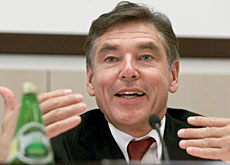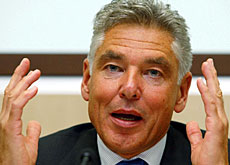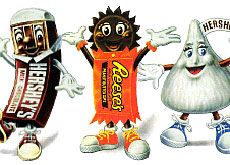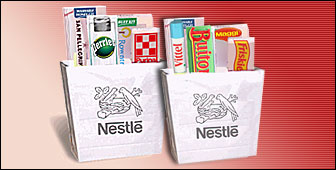Nutrition set to nurture Nestlé growth

Conservative but consistent is perhaps the best way to sum up the corporate culture at Nestlé, the world's number one food and beverages group.
In an interview with swissinfo, chief executive Peter Brabeck explains the strategy that has made Nestlé a financial success story that other firms can but envy.
There was some disappointment at the Swiss multinational’s figures for the first nine months of 2002, with real internal growth slowing down. But Brabeck is confident that Nestlé will once again turn in higher sales and profits for the year as a whole.
The focus of Nestlé over the past five years has not been on chocolate or coffee, as might be expected from a company that produces Nescafé and KitKat.
At Nestlé headquarters in Vevey on Lake Geneva, Brabeck explained to Robert Brookes that the company had seen better growth potential in bottled water, pet food and ice cream.
However, Nestlé now looks set to target its future acquisition strategy on nutrition, after careful research into demographic trends.
swissinfo: How does Nestlé continue year in and year out to be a successful company?
I think because we have a very broad geographical presence, a very broad product portfolio and we have above all a consistent management team and collaborators who have been with the company for many years. I think this consistency, this long-term thinking, and not falling into the trap of short-term fashions or fads is certainly one of the most important factors for the continuing success of Nestlé.
How are you planning to continue this success? What is your strategy?
Our strategy is well known and is based on four pillars. The first is operational performance and efficiency. Five years ago, we launched “Market Heads 97” – the first efficiency programme – which gave us SFr4 billion of savings. This has been replaced now by “Target 2004”. As a second pillar we have innovation and renovation, building on our unique capabilities of research and development. We have a third pillar called availability – whenever, wherever, however. We want our products to be available wherever the consumers want them and finally we have our communications strategy.
As the world’s number one food company, you also have an appetite at Nestlé. What are the criteria that you use when you make acquisitions?
Basically, it has to make strategic sense. For example, four or five years ago, I clearly identified that we wanted to be stronger in certain areas where the top line growth was bigger than in others. These were ice cream, water and pet food. Ninety-five per cent of all acquisitions that we have made over the past five years are concentrated in these areas. It was a strategic fit. Secondly, the acquisition target has to be culturally and from a value point compatible with the Nestlé values and in 99.9 per cent of cases we want to have a friendly merger climate.
You mentioned the three priority areas of pet food, ice cream and water. What next?
It’s true that in these three areas we are now very close to what we call the “end game situation”, so that basically we cannot make many more acquisitions there and that we will now have to grow internally. We are now looking for new opportunities in the area of nutrition. This is a prime priority now for Nestlé and in very selected areas of food and confectionery also.
Why nutrition?
If you analyse the demographic trends, you can clearly identify that there is, on the one hand, the growing infant population that needs special nutrition, but there is also the new phenomenon of the growing older population, which also needs special nutrition. Those areas have not been sufficiently exploited up to now and they are high growth areas with high value products. What you also see is that as people have more and more income available, they are less concerned with eating in order to be able to live, and more concerned with enjoying food. From that they move forward into the area of nutrition and wellness to finally get to a state of well being. In this process of development, nutrition plays a crucial role and this is therefore the area in which we want to concentrate.
Henri Nestlé introduced his infant cereal in 1867.
Nescafé was launched in 1938.
Nestlé has 468 factories in 84 countries, with a staff of 229,765 (Management Report 2001).
Nestlé has a 49 per cent stake in L’Oréal, the world’s number one cosmetics group.
Nestlé has developed a KitKat bar with a banana flavour for the Japanese market.
Sales for the first nine months of 2002 were SFr66.2 billion.
Major acquisitions have included: Carnation (1985), Buitoni (1988), Rowntree (1988), Perrier (1992), Sanpellegrino (1998), Spillers Petfoods (1998) and Ralston Purina (2001).

In compliance with the JTI standards
More: SWI swissinfo.ch certified by the Journalism Trust Initiative




You can find an overview of ongoing debates with our journalists here. Please join us!
If you want to start a conversation about a topic raised in this article or want to report factual errors, email us at english@swissinfo.ch.